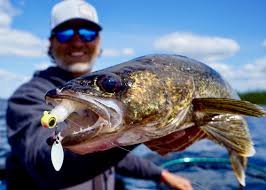1. Understand Walleye Behavior
-
- Walleye are most likely to be available during the darker times
-
- They will survive in water temperatures from 65°F to 75°C
-
- Allow them to be close to the bottom of the lake or in the rocks and underwater structures
2. Choose the Right Location
-
- Find out the places where there are rocky edges, reefs, and fall-offs on the water body
-
- Target edges of weed and sand flats
-
- Fish the river mouths and current breaks
3. Time Your Fishing
-
- A substantial increase in fishing activity is seen at dawn and dusk
-
- Night fishing may be very lucrative
-
- Their behavior is slightly different in overcast days when they eat over longer periods
4. Use Effective Techniques
-
- Jigging: Jig with live baits or soft plastics
-
- Trolling: Use crankbaits that can cover a large area
-
- Live Bait Rigging: Minnows, nightcrawlers, or leeches can be used for this
-
- Casting: This way is successful when you go to rivers or shallow areas
5. Select the Right Gear
-
- The rod that is 6-7 foot long with medium action spinning
-
- Reel with a drag system that runs smoothly
-
- A test line of 6-10 lb (fluorocarbon or monofilament)
-
- A variety of jigs, cranks, and live bait rigs are available to try immediately
6. Adapt to Seasons
-
- Spring: The priority is shallow spawning areas
-
- Summer: Focus on the deeper structures
-
- Fall: Imitate baitfish in the areas with a congregation of them
-
- Winter: Trout fish in the deep ocean basins or near objects
7. Use Electronics
-
- The use of fish finders that are qualified for the detection of schools
-
- Take note of the bottom contours and structure
8. Practice Patience and Persistence
Walleyes are considered scarce, so it is of the utmost importance to stay patient and may be, try different methods and locations.
9. Follow Regulations
All the time, the responsibility lies with the people to get the licenses and check the local fishing regulations.
Please remember that the achievement of walleye fishing quite, usually comes down to the experience and total understanding of the fish. Keep practicing, and you’ll improve over time. Good luck and enjoy your fishing adventure!

0 Comments